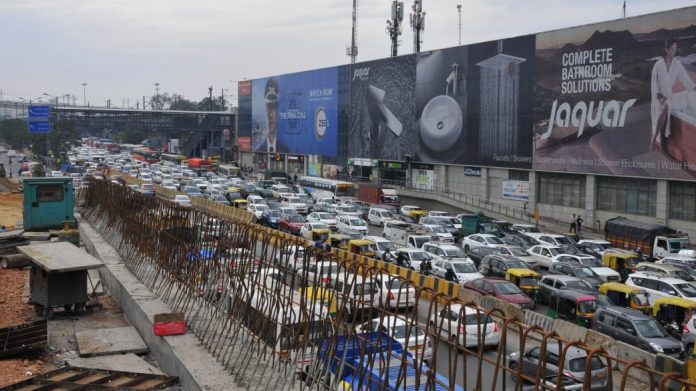
New Delhi: On one side of Subroto Park in New Delhi, still under construction, stands one of the world’s slowest infrastructure projects, the Rao Tula Ram (RTR) Marg flyover. On the other side, cars whizz by on their way from the airport and Gurugram towards Dhaula Kuan, using a swanky new flyover inaugurated earlier this month.
The 2.7 km-long RTR flyover project, supposed to ease traffic movement between south Delhi and the airport, was launched in November 2014, but is still incomplete as work has progressed at a rate of only about 400 metres per year.
The other flyover, which covers a 2 km stretch between the Parade Road crossing and Dhaula Kuan, was constructed and inaugurated in 136 days, or four-and-a-half months.
It was developed to decongest National Highway 8 (NH 48 as per the new numbering system) and make the Dhaula Kuan-airport stretch signal-free. The flyover was inaugurated by Road Transport Minister Nitin Gadkari on 2 March.
How did things move so quickly?
Gadkari had asked the National Highways Authority of India (NHAI) if it could do a survey of the route, following which the requirement of land was prepared. The project needed about five acres of defence land, but it was not forthcoming, despite discussions with the Ministry of Defence at various levels.
A senior government official, who did not wish to be identified, said the project would have been stuck were it not for the personal intervention of the late Manohar Parrikar when he was union defence minister (until March 2017).
“The project hadn’t yet been formulated, but it was understood that once we got the land, we would do the project,” the official said. “It was personal intervention from Manohar Parrikar and Nitin Gadkari that made it possible. Parrikar walked the route three times with very senior officers of the army and the air force.”
After Parrikar’s intervention, the NHAI acquired the defence land in about six months. Drawing up plans and awarding tenders took another few months, but by March 2018, the flyover was ready for construction at an estimated cost of Rs 270 crore. However, security restrictions and the lack of clearance from the Ministry of Environment, Forest and Climate Change caused another four-month delay in the start of construction.
Finally, once the green clearances were obtained, work on the flyover began towards the end of October 2018.
Huge challenges
The project faced huge challenges in terms of traffic management of about 3 lakh passenger cars per day, the presence of a large number of civil and defence utilities, shifting of defence infrastructure, and getting security and forest clearances.
Another major hurdle, according to NHAI officials, was the Indraprastha Gas Limited pipelines on the route.
In addition, the fact that this stretch is part of the VVIP route meant that construction work had to be regularly halted. However, this also meant that there was a lot of top-level interest in this project.
“Most ministers, VVIPs and even the NHAI chairman travelled every day to office by this route, which is why we were getting a constant feedback. We constructed a site office at Dhaula Kuan to have a round-the-clock control room to monitor the work,” said an NHAI official.
One factor that did make the NHAI’s life easier was that the financial aspects of the project were taken care of by the ministry itself, so there was no dependency on any third party that could’ve delayed it.
Associated projects set to be completed soon
The completed flyover is only 60 per cent of the entire project, which includes uniform eight-laning, underpasses at Parade Road, Army Environmental Park and Training Area and R&R Hospital, and a new foot over bridge. According to NHAI officials, the entire project is on course for completion by the end of June.
Not the first fast-paced NHAI project
While it’s true that projects in India tend to take a long time to complete due to various reasons, including bureaucratic red-tapism, the NHAI has executed fast-paced projects in the past too.
For example, the 135 km-long six-lane Eastern Peripheral Expressway was completed in just 500 days.
Similarly, four flyovers and four underpasses in Gurugram were built in 13 months, comfortably beating the set target of 30 months.
Separate fact from fiction, the real from the fake going viral on social media, on HoaXposed .